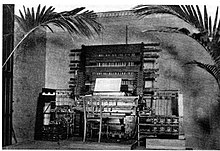Telharmonium
The telharmonium (also called dynamophone ) is considered to be the first electromechanical musical instrument . A patent was applied for in 1896. The first prototype was built in 1900 by its inventor Thaddeus Cahill in Washington, DC . The largest telharmonium weighed around 200 tons, was the size of a cathedral organ and was used, among other things, for remote musical transmission over the telephone . (So you could listen to pieces of music over the phone.) Despite its enormous size, it was also transported across the United States for concerts, filling up to 30 freight cars.
The Telharmonium operates on the principle of a gear generator (Each gear generates a sound. The number of teeth of a wheel determined in conjunction with the speed of the pitch.). The plant was u. a. So big because there were no electronic amplifiers yet and the tone generators were therefore real electrical alternating current generators , which had to generate the power for all loudspeakers connected via the telephone network (telephone receiver with or without a funnel) in order to provide all listeners with sufficient sound pressure . The voltages of the generators were mixed together via a complex system of switches and transformers in order to create different timbres through additive synthesis , which could be played with velocity and velocity on an organ console with several keyboards .
A total of three of these systems were built, none of which have been preserved, and no existing sound recordings are known.
See also
literature
- André Ruschkowski: Electronic sounds and musical discoveries (= universal library 9663 Reclam knowledge ). Revised and expanded edition of "Soundscapes". Reclam, Stuttgart 1998, ISBN 3-15-009663-4
- Reynold Weidenaar: Magic Music from the Telharmonium. The Scarecrow Press Inc., Metuchen NJ et al. 1995, ISBN 0-8108-2692-5
Web links
- Detailed description Telharmoniums (English) ( Memento of 23 January 2009 at the Internet Archive )
- Technical details, pictures of the patent specification. (English)
- 120 Years of Electronic Music - Thaddeus Cahill's "Dynamophone / Telharmonium" (1897) ( Memento from March 16, 2009 in the Internet Archive )
- Documentary film Magic Music from the Telharmonium by Reynold Weidenaar
Individual evidence
- ^ Thomas B. Holmes, Thom Holmes: Electronic and Experimental Music: Pioneers in Technology and Composition . Psychology Press, 2002, ISBN 978-0-415-93644-6 , pp. 43-.
